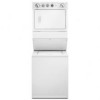Whirlpool WET3300SQ User Instructions - Page 13
Connect the Inlet Hoses
 |
UPC - 883049046570
View all Whirlpool WET3300SQ manuals
Add to My Manuals
Save this manual to your list of manuals |
Page 13 highlights
For laundry tub or standpipe drain systems 1. Make sure drain hose form is in correct position. A Connect the inlet hoses to the washer 1. Attach the hot water hose to the bottom inlet valve. Attaching the hot water hose first makes it easier to tighten connection with pliers. 2. Screw on coupling by hand until it is seated on the washer. 3. Using pliers, tighten the couplings with an additional twothirds turn. NOTE: Do not overtighten or use tape or sealants on the valve. Damage to the valves can result. In the U.S.A. A. Drain hose form 2. Put hooked end of drain hose into laundry tub or standpipe. Rotate hook to eliminate kinks. To keep drain water from going back into the washer: ■ Do not force excess drain hose into standpipe. Hose should be secure but loose enough to provide a gap for air. ■ Do not lay excess hose on the bottom of the laundry tub. For use with floor drain Do not install the drain hose form onto the corrugated drain hose. You may need additional parts. See Floor drain under "Tools and Parts." Connect the Inlet Hoses 1. Insert a new flat washer into each end of the inlet hoses. Firmly seat the washers in the couplings. A B A. Coupling B. Washer Connect the inlet hoses to the water faucets Make sure the washer basket is empty. 1. Attach hose to the hot water faucet. Screw on coupling by hand until it is seated on the washer. 2. Attach hose to the cold water faucet. Screw on coupling by hand until it is seated on the washer. 3. Using pliers, tighten the couplings with an additional twothirds turn. A In Canada B A. Cold water inlet valve (top) B. Hot water inlet valve (bottom) A B A. Cold water inlet valve (top) B. Hot water inlet valve (bottom) 4. Attach the cold water hose to the top inlet valve. 5. Screw on coupling by hand until it is seated on the washer. 6. Using pliers, tighten the couplings with an additional two- thirds turn. NOTE: Do not overtighten or use tape or sealants on the valve. Damage to the valves can result. If you are working in a closet or recessed area Move the washer/dryer into its final location and remove cardboard from under washer/dryer. Remove the access panel by removing 3 Phillips-head screws and one bumper, located at the top of the access panel. Set panel, screw, and bumper aside. Complete hookup of water hoses. Replace access panel upon completion of washer/dryer installation. NOTE: Do not overtighten or use tape or sealants on the valve. Damage to the valves can result. Clear the water lines ■ Run water through both faucets and inlet hoses, into a bucket or laundry tub, drainpipe or bucket to get rid of particles in the water lines that might clog the inlet valve screens. ■ Check the temperature of the water to make sure that the hot water hose is connected to the hot water faucet and that the cold water hose is connected to the cold water faucet. Check for leaks ■ Turn on the water faucets and check for leaks. A small amount of water might enter the washer. You will drain this water later. NOTE: Replace inlet hoses after 5 years of use to reduce the risk of hose failure. Record hose installation or replacement dates for future reference. ■ If you connect only one water hose, you must cap off the remaining water inlet port. ■ Periodically inspect and replace hoses if bulges, kinks, cuts, wear, or leaks are found. ■ The apparatus must be connected to the water faucets using the new hoses. Do not use old hoses. 13















